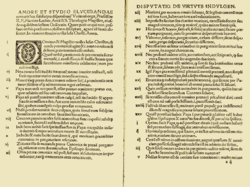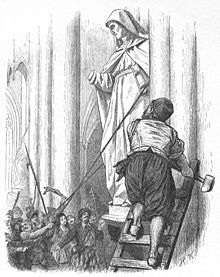Andreas Karlstadt
You can help expand this article with text translated from the corresponding article in German. (November 2017) Click [show] for important translation instructions.
|
Andreas Karlstadt | |
|---|---|
Bishopric of Würzburg | |
| Died | 24 December 1541 (aged 55) Basel, Canton of Basel, Swiss Confederation |
| Occupation | Theologian |
| Theological work | |
| Era | Protestant Reformation |
Andreas Rudolph Bodenstein von Karlstadt (1486 – 24 December 1541), better known as Andreas Karlstadt, Andreas Carlstadt or Karolostadt,
Karlstadt became a close associate of Martin Luther and one of the earliest
Karlstadt operated as a church reformer largely in his own right, and after coming in conflict with Luther, he switched his allegiance from the
Education
Karlstadt received his doctorate of
In the same year in which Karlstadt received his doctorate he became
Reformation
| Part of a series on the |
| Reformation |
|---|
 |
| Protestantism |

Before 1515, Karlstadt was a proponent of a modified
In 1519, Johann Eck challenged Karlstadt to the Leipzig Debate. There, Eck debated with Luther as well as Karlstadt.[2]
On 15 June 1520 Pope Leo X issued the papal bull Exsurge Domine that threatened Luther and Karlstadt with excommunication, and condemned several of their theses. Both reformers remained steadfast, and excommunication followed in 1521 in the papal bull Decet Romanum Pontificem.[2]
After the
In early January 1522, the Wittenberg city council authorized the removal of imagery from churches and affirmed the changes introduced by Karlstadt on Christmas. Karlstadt wrote his thesis "On the Removal of Images and That There Should Be No Beggars Among Christians" in 1522, shortly after this authorization from the city council. On 19 January Karlstadt married Anna von Mochau, the fifteen-year-old daughter of a poor nobleman. On 20 January the imperial government and the Pope ordered Frederick the Wise, Elector of Saxony to undo the changes. Frederick let most of the Mass revert to its Catholic form, but in a letter to the Wittenberg Council, he noted his personal compassion for Karlstadt.
Relationship with Luther
In the first week of March, Luther returned from Wartburg. From 9–16 March Luther gave eight sermons in which he stressed some theological similarities with Karlstadt, but, in hindsight, urged caution. This was a major turning point between Karlstadt and Luther. Karlstadt reasserted some of his moderately mystical leanings, continued wearing peasants' clothing, asked to be called "Brother Andreas," and became disillusioned with academic life. In fact, he renounced his three doctoral degrees, and, according to one source,[citation needed] "gave excellent but infrequent lectures."
In May 1523, Karlstadt was invited by the church of Orlamünde to be its pastor, and he accepted at once. Here he instituted all his radical reforms, and
From Spring 1524, Luther started to campaign against Karlstadt, denying his right to publish and preach without Luther's authorization. In June, Karlstadt resigned as archdeacon. In July, Luther published the Letter to the Saxon Princes, in which he argued that Thomas Müntzer and Karlstadt agreed, and were both dangerous sectarians with revolutionary tendencies. Karlstadt defended the observance of the Sabbath, the seventh day of the week, as a holy day to the Lord. Martin Luther differed from him as he believed that Christians were free to observe any day of the week, provided it was uniform.[3] His defense of the Sabbath, and others among the Anabaptists, caused him to be censured as a Jew and a heretic.[4]
On 22 August 1524, Luther preached in Jena. Karlstadt hid in the crowd during Luther’s preaching, and wrote to Luther, asking to see him. This led to the well-known confrontation at the Black Bear Inn in a conversation recorded by a Martin Reinhardt and published within a month. There were a number of misunderstandings between the two men. For example, Luther said that he was convinced that Karlstadt had revolutionary tendencies, despite the fact that Karlstadt had all along rejected violence in the name of religion, and rejected Thomas Müntzer's invitation to join the League of the Elect. Karlstadt's answer was published in 1524 in Wittenberg, and is still extant. This showed that Karlstadt continued to reject the violence that led to the German Peasants' War. Another defamation was Luther's accusation that Karlstadt was not authorized to preach at the city church in Wittenberg during Luther’s stay at Wartburg. The conversation ended when Luther gave Karlstadt a guilder and told him to write against him. In September 1524 Karlstadt was exiled from Saxony by Frederick the Wise and George, Duke of Saxony. Luther also wrote against Karlstadt in his 1526 The Sacrament of the Body and Blood of Christ—Against the Fanatics.
Peasant War
When the Peasant War broke out, Karlstadt was threatened and wrote to Luther and asked for assistance. Luther took him in, and Karlstadt lived secretly in Luther's house for eight weeks. However, Karlstadt had to sign a pseudo retraction, titled "Apology by Dr. Andreas Karlstadt Regarding the False Charge of Insurrection Which has Unjustly Been Made Against Him." It also contained a preface by Luther. In March, Katharina, Luther's wife, became godmother to one of Karlstadt's children. Karlstadt was not allowed to preach or publish, and supported his family as a farmer and peddler near Wittenberg until 1529.[5]
Iconoclasm and Marian views
Some of the Protestant reformers, in particular Andreas Karlstadt, together with Huldrych Zwingli and John Calvin encouraged the removal of religious images by invoking the Decalogue's prohibition of idolatry and the manufacture of graven images of God. As a result, religious statues and images were destroyed and damaged in spontaneous individual attacks as well as unauthorised iconoclastic riots. Erasmus described in a letter of 1529 such a riot that had occurred in Basel:
They heaped such insults on the images of the saints, and the crucifix itself, that it is quite surprising there was no miracle. ... Not a statue was left either in the churches, or the vestibules, or the porches, or the monasteries. The frescoes were obliterated by means of a coating of lime; whatever would burn was thrown into the fire, and the rest pounded into fragments. Nothing was spared for either love or money.[6]
Karlstadt has been seen as closely associated with "Bildersturm" (see Beeldenstorm), as he was at the time. In 1522, he convinced the Council of Wittenberg to order the removal of a number of images from the local churches, which had "catastrophic consequences."[7] Martin Luther distanced himself from these actions. On 12 March 1522 Karlstadt spoke about Marian pictures, which were venerated at the time, and urged that they all be removed. Special aim was taken at Marian pictures visited in pilgrimages, but he also called for the removal of all public religious imagery and symbols. He asked for the destruction of Marian shrines such as the church Mary the Beautiful in Regensburg.[citation needed] Karlstadt was supported by Martin Bucer, Huldrych Zwingli and John Calvin.[8]
Yet this was more than a local German event. Significant iconoclastic riots took place in

Death and legacy
Fleeing Saxony, Karlstadt served as a minister in Switzerland in Altstätten and Zürich.[9] In 1534, he went to Basel as minister of the university church and Professor of Hebrew and Dean of the university. He remained in Basel until he died of the plague on 24 December 1541.[10]
During Karlstadt's lifetime he published about 90 writings in about 213 editions. Between the years 1518–1525, 125 editions of his works were published in
Works
- On the Canon of Scripture (in Latin, De canonicis scripturis libellus 1520; in German, 1521-2)
- On the Removal of Images [1] [Von abtuhung der Bylder], (Wittenberg 1522)
- On Baptism [Dialogus vom Tauff der Kinder], (Worms 1527)
- Letter from the Community of Orlamünde to the people of Allstedt, on how Christians ought to fight., (Wittenberg: 1524).
References
- ^ "Carlstadt". The Columbia Electronic Encyclopedia, 6th ed. Retrieved 2009-07-10.
- ^ a b c d e Chisholm 1911, p. 348.
- ^ Andrews, John N. (1873). History of the Sabbath and First Day of the Week (2 ed.). Battle Creek: Steam Press of the Seventh-Day Adventist Publishing Association. pp. 446, 456.
- ^ White, Francis (1635). A Treatise of the Sabbath-Day: Containing, a Defence of the Orthodoxall Doctrine of the Church of England, Against Sabbatarian-Novelty. London: Richard Badger. p. 8.
- ISBN 978-0-631-21839-5.
- ^ Erasmus, Epistle MXLVIII to Bilibald
- ^ Bildersturm in Bäumer, Marienlexikon, Regensburg, 1988, p. 481.
- ^ Bäumer 481
- ^ Chisholm 1911, p. 349.
- ISBN 978-0-631-21839-5.
Attribution:
- Chisholm, Hugh, ed. (1911). . Encyclopædia Britannica. Vol. 5 (11th ed.). Cambridge University Press. pp. 348–349.
Further reading
- Andreas Carlstadt: The Reformation goes Radical, by John L. Hoh, Jr. (From Leaders of the Reformation, 2007, i-Proclaim/HoneyMilk Publications.)
- The Eucharistic Pamphlets of Andreas Bodenstein von Karlstadt Ed. and trans. Amy Nelson Burnett. Kirksville, MO: Truman State University Press, c2011. ISBN 978-1-935503-16-3.
- Bainton, Roland H. Here I Stand. Nashville: Abingdon Press, 1950.
- Amy Nelson Burnett, Karlstadt and the Origins of the Eucharistic Controversy; A Study of the Circulation of Ideas (Oxford: Oxford University Press, 2011).
- Furcha, E.J. (Ed.) The Essential Carlstadt. Scottdale, Pennsylvania: Herald Press, 1995.
- Leroux, Neil R. 2003. Karlstadt’s christag predig: Prophetic rhetoric in an "evangelical" mass. Church History: 102-137.
- Pater, Calvin Augustine. Karlstadt as the Father of the Anabaptist Movements Toronto: University of Toronto Press, 1984,86.
- Sider, Ronald J. (Ed.) Karlstadt’s Battle With Luther. Philadelphia: Fortress Press, 1978.
External links
- Karlstadt, Andreas Rudolff-Bodenstein von (1486-1541) in Global Anabaptist Mennonite Encyclopedia Online
- Karlstadt-Edition
- Kritische Gesamtausgabe der Schriften und Briefe Andreas Bodensteins von Karlstadt in the Digital Library of the Herzog August Bibliothek Wolfenbüttel, Germany
